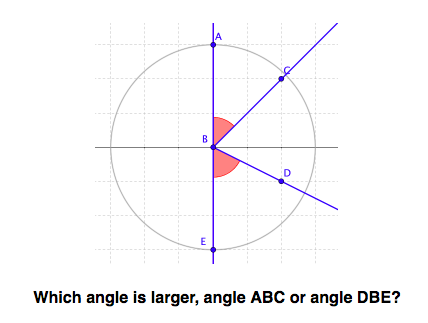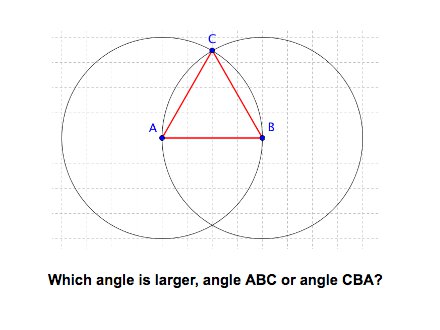Evidence of Understanding
- describe qualities that make two angles congruent or incongruent
- define an angle using its vertex and rays
- recognize that as an angle measure increases, its arc measure increases
- define all straight angles as having 180° and are therefore all congruent angle measures
- show and describe why an angle whose arc measure is 180° is also a semi-circle
- show and describe why an angle whose arc measure is 360° is also a complete circle
- justify which qualities are mathematically significant or insignificant for determining if two angles are the same
- Example: degree measure vs. color of the angle, length of the rays, thickness, etc.
- Example: degree measure vs. color of the angle, length of the rays, thickness, etc.
- define an angle using its vertex and rays
- construct congruent angles and justify their congruence
- compare methods for determining congruence and describe advantages of each type
- Examples: paper folding, placing angles on the coordinate grid, using patty paper or online software to translate, rotate, or reflect image, etc.
- given an angle, create a congruent angle, and explain why they are congruent
- use notation to signify congruence
- consider and describe implications of human error
- bisect an angle and justify congruence of both parts
- use angle addition to explain that each part is half the degree measure of the whole
- construct congruent right angles using a perpendicular bisector
- compare methods for determining congruence and describe advantages of each type
- perform constructions and analyze the relationships among the segments or angles created
- explore congruent relationships between segments and angles formed by constructing a perpendicular bisector
- describe how two congruent angles are sectors of the same circle, including congruent radii and arc measures
Develop conceptual understanding:
angle, vertex, ray, degree measure, sector of a circle, perpendicular, angle addition, right angle, perpendicular, perpendicular bisector, straight angleSupporting terms to communicate:
congruent, incongruent, point, line, line segment, length measure, acute, obtuse, circle, arc, radius, equidistant, distance, bisect, midpoint, compass, construction, partition, protractor




